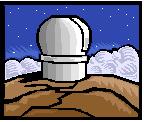SLOOH
Bill Otten - Largo, Florida

Dismal weather here tonight. Tropical storm force winds from the gulf, with driving rain... and that comet I've been wanting to view is supposed to be prime viewing tonight. Perhaps you're watching WGN in the midst of one of those famous northern Illinois winters and the weather prediction calls for overcast skies, plummeting temperatures and a lake effect snow? Regardless of where you live, weather that precludes that planned astronomical tryst with the telescope happens, and all too often. In the course of a long stretch of such weather, even armchair astronomy with back issues of S&T doesn't satisfy that deep sky craving.
Thankfully, there's an excellent solution residing 12,194 ft high upon the peak of Mt. Teide in the Canary Islands. A prime location for astronomy, the peaks hosts equipment from 19 countries and some 60+ academic institutes. The cool ocean currents mingling with trade winds produce an ideal site for telescopes, with little atmospheric turbulence. Most clouds form well below the peak, ensuring that 80% of the nights are prime for viewing or imaging. Within this group are the telescopes of SLOOH, a project launched on December 25, 2003. Two 14" CCD equipped Schmidt-Cassegrain telescopes in separate motorized domes, along with an 85mm apochromat form the basis of the SLOOH system. Link that with some powerful remote imaging software and a direct connection to the SLOOH servers and the Internet and the clear dark skies of the Canary Islands are available in real time for some serious deep sky work.
Since it began in December 2003, some 339,000 images have been sent, amassing one of astronomy's most prolific image libraries. An evening connected to SLOOH allows both 'group' and 'solo' missions. Group missions are objects the majority of astronomy buffs would have an interest in....planets, Messier objects, as well as NGC and other objects such as comets, variable stars, supernovae, and the like. Objects are suggested by members and agreed upon and the scope missions programmed into the SLOOH telescopes. Each mission lasts from 5 to 15 minutes while the CCD's collect their light utilizing various filter systems. Nearly 50 group missions per night is the norm. The composite images are then combined. 'Snapshot' images can be taken at any time during the light captures of the CCD's in real time for those wishing to do their own processing of the various images that make up a composite. It all happens in real time and occasionally one is lucky enough to capture an image of a meteor trail passing through the field. More importantly, the variety and intensity of beautiful deep sky objects is tremendous. Besides the group missions, membership has its rewards.....members are allotted solo time on the scopes for objects of their choosing. One of the 14" SCTs is devoted to group missions, the other to solo missions. The apochromat provides wide field views of the skies and a separate all-sky fisheye camera mounted outside the domes provides the all-sky views on the Internet interface. During the group missions, a narration on each object is transmitted via the Internet, so the group objects become a genuine learning experience. Additionally, a network chat is held between the scope operations team, special guests and the members of SLOOH several evenings a month. I've found the evening chats and discussion about images, objects, and astronomy in general to be very academic and informative. Most nights, astronomers are online too, so the discussion can get intense. The Canary Islands are 5 hours ahead of EST so viewing begins in the mid afternoon up until about midnight or 1 a.m. local time EST. One can get in a pretty full 'night' of astronomy and still get a good night's sleep! What a concept!
SLOOH has a members-only group on Yahoo just like LCAS. Members can post their latest images, discuss current events, and keep track of telescope happenings on Mt. Teide on the group. Members come from all points on the globe, which is a plus if you're interested in contact with amateur and professional astronomers world wide.
SLOOH membership is either monthly or yearly. On a monthly basis, the cost is $7.95. I consider this a bargain in terms of the number of hours of enjoyment I get in participation monthly. In real terms...compare this to the round trip cost of gasoline to travel to the LCAS remote viewing sites, and I'm sure you'll agree with me.
More information on the SLOOH experience can be found at: www.slooh.com





